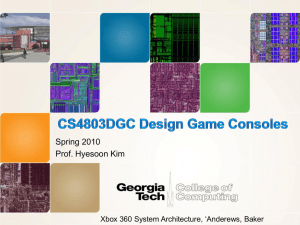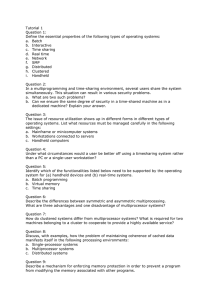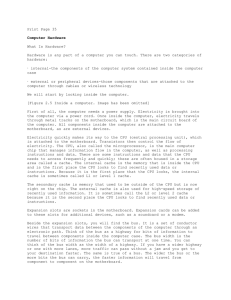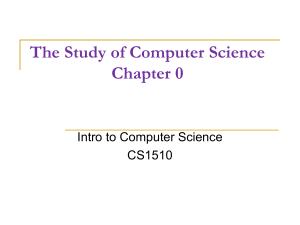Spring 2011 Prof. Hyesoon Kim Xbox 360 System Architecture, „Anderews, Baker
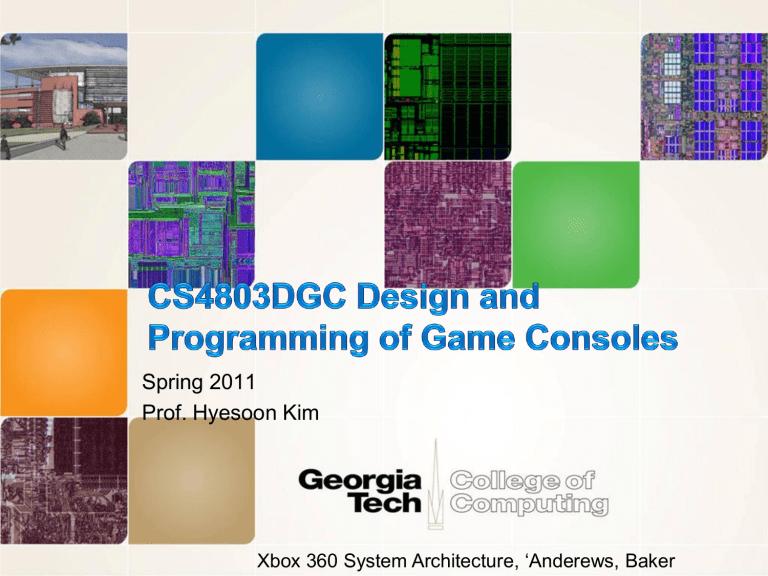
Spring 2011
Prof. Hyesoon Kim
Xbox 360 System Architecture, „Anderews, Baker
• 3 CPU cores
– 4-way SIMD vector units
– 8-way 1MB L2 cache (3.2 GHz)
– 2 way SMT
• 48 unified shaders
• 3D graphics units
• 512-Mbyte DRAM main memory
• FSB (Front-side bus): 5.4 Gbps/pin/s (16 pins)
• 10.8 Gbyte/s read and write
• Xbox 360: Big endian
• Windows: Little endian http://msdn.microsoft.com/en-us/library/cc308005(VS.85).aspx
• L2 cache :
– Greedy allocation algorithm
– Different workloads have different working set sizes
• 2-way 32 Kbyte L1 I-cache
• 4-way 32 Kbyte L1 data cache
• Write through, no write allocation
• Cache block size :128B (high spatial locality)
• 2-way SMT,
• 2 insts/cycle,
• In-order issue
• Separate vector/scalar issue queue (VIQ)
Vector
Vector
Execution
Unit
Instructions
Scalar
Scalar
Execution
Unit
• First game console by Microsoft, released in 2001, $299
Glorified PC
–
733 Mhz x86 Intel CPU, 64MB DRAM, NVIDIA GPU (graphics)
– Ran modified version of Windows OS
– ~25 million sold
• XBox 360
– Second generation, released in 2005, $299-$399
– All-new custom hardware
– 3.2 Ghz PowerPC IBM processor (custom design for XBox 360)
– ATI graphics chip (custom design for XBox 360)
– 34+ million sold (as of 2009)
• Design principles of XBox 360 [Andrews & Baker]
- Value for 5-7 years
-!ig performance increase over last generation
- Support anti-aliased high-definition video (720*1280*4 @ 30+ fps)
- extremely high pixel fill rate (goal: 100+ million pixels/s)
- Flexible to suit dynamic range of games
- balance hardware, homogenous resources
- Programmability (easy to program)
Slide is from http://www.cis.upenn.edu/~cis501/lectures/12_xbox.pdf
• Code name of Xbox 360‟s core
• Shared cell (playstation processor) ‟s design philosophy.
• 2-way SMT
• Good: Procedural synthesis is highly multi-thread
• Bad: three types of game-oriented tasks are likely to suffer from the lack of high ILP support: game control, artificial intelligence (AI), and physics.
• ISA: 64-bit PowerPC chip
– RISC ISA
– Like MIPS, but with condition codes
– Fixed-length 32-bit instructions
– 32 64-bit general purpose registers (GPRs)
• ISA++: Extended with VMX-128 operations
– 128 registers, 128-bits each
– Packed “vector” operations
– Example: four 32-bit floating point numbers
– One instruction: VR1 * VR2 ! VR3
– Four single-precision operations
– Also supports conversion to MS DirectX data formats
• Works great for 3D graphics kernels and compression
• 3.2 GHZ
• Peak performance Peak performance: ~75 gigaflops
Slide is from http://www.cis.upenn.edu/~cis501/lectures/12_xbox.pdf
• Four-instruction fetch
• Two-instruction “dispatch”
• Five functional units
• “VMX128” execution
“decoupled” from other units
• 14-cycle VMX dot-product
• Branch predictor:
• “4K” G-share predictor
• Unclear if 4KB or 4K 2-bit counters
• Per thread
• Issue and Dispatch mean differently depending on companies, academia etc. intel Issue dispatch
Scheduler/Reservation station
FU
IBM dispatch issue
• Uni-Processor: 4-6 wide, lucky if you get 1-2 IPC
– poor utilization
• SMP: 2-4 CPUs, but need independent tasks
– else poor utilization as well
• SMT: Idea is to use a single large uni-processor as a multi-processor
Regular CPU
CMP
2x HW Cost
SMT (4 threads)
Approx 1x HW Cost
• For an N-way (N threads) SMT, we need:
– Ability to fetch from N threads
– N sets of architectural registers (including PCs)
– N rename tables ( RATs )
– N virtual memory spaces
– Front-end: branch predictor?: no, RAS? :yes
• But we don‟t need to replicate the entire OOO execution engine (schedulers, execution units, bypass networks, ROBs, etc.)
16
• Multiplex the Fetch Logic
PC
0
PC
1
PC
2 cycle % N
I$ fetch Decode, etc.
Can do simple round-robin between active threads, or favor some over the others based on how much each is stalling relative to the others
RS
17
• Thread #1‟s R12 != Thread #2‟s R12
– separate name spaces
– need to disambiguate
Thread
0
Register #
RAT
0
Thread
1
Register #
RAT
1
PRF
18
• No change needed
Thread 0:
Add R1 = R2 + R3
Sub R4 = R1
– R5
Xor R3 = R1 ^ R4
Load R2 = 0[R3]
Thread 1:
Add R1 = R2 + R3
Sub R4 = R1
– R5
Xor R3 = R1 ^ R4
Load R2 = 0[R3]
Thread 0:
After Renaming
Add T12 = T20 + T8
Sub T19 = T12
– T16
Xor T14 = T12 ^ T19
Load T23 = 0[T14]
Thread 1:
Add T17 = T29 + T3
Sub T5 = T17
– T2
Xor T31 = T17 ^ T5
Load T25 = 0[T31]
Shared RS Entries
Sub T5 = T17 – T2
Add T12 = T20 + T8
Load T25 = 0[T31]
Xor T14 = T12 ^ T19
Load T23 = 0[T14]
Sub T19 = T12 – T16
Xor T31 = T17 ^ T5
Add T17 = T29 + T3
19
• Each process has own virtual address space
– TLB must be thread-aware
• translate (thread-id,virtual page) physical page
– Virtual portion of caches must also be threadaware
• VIVT cache must now be (virtual addr, thread-id)indexed, (virtual addr, thread-id)-tagged
• Similar for VIPT cache
• No changes needed if using PIPT cache (like L2)
20
• Register File Management
– ARF/PRF organization
• need one ARF per thread
• Need to maintain interrupts, exceptions, faults on a per-thread basis
– like OOO needs to appear to outside world that it is in-order, SMT needs to appear as if it is actually N CPUs
21
• When it works, it fills idle “issue slots” with work from other threads; throughput improves
• But sometimes it can cause performance degradation!
Time( ) < Time( )
Finish one task, then do the other
Do both at same time using SMT
22
• Cache thrashing
I$ D$
Thread
0 just fits in the Level-1 Caches
Context switch to Thread
1
Executes reasonably quickly due to high cache hit rates
I$ D$
Thread
1 also fits nicely in the caches
L2
I$ D$
Caches were just big enough to hold one thread‟s data, but not two thread‟s worth
Now both threads have significantly higher cache miss rates
23
• Four-way SIMD VMX 128 units:
– FP, permute, and simple
• 128 registers of 128 bits each per hardware thread
• Added dot product instruction (simplifying the rounding of intermediate multiply results)
• 3D compressed data formats . Use compressed format to store at L2 or memory. 50% of space saving.
• Microsoft refers to this ratio of stored scene data to rendered vertex data as a compression ratio , the idea being that main memory stores a "compressed" version of the scene, while the GPU renders a "decompressed" version of the scene.
From http://arstechnica.com/articles/paedia/cpu/xbox360-1.ars/2
• Scalable “virtual” artists
• Reduction of bandwidth from main memory to GPUs
• Tessellation: The process of taking a higher order curve and approximating it with a network of small flat surfaces is called tessellation.
• Traditional GPU: Artist
• Xbox 360: using Xeon
• Real time tessellation
– Another form of data compression
– Instead of list of vertex, stores them as higher order of curves
– Dynamic Level of Detail (LOD)
• Keep the total number of polygons in a scene under control
From http://arstechnica.com/articles/paedia/cpu/xbox360-1.ars/2
Images are from shi et al.‟s “Example-based Dynamic Skinning in Real Time ”
• Artists use standard tools to generate a character model a long with a series of key poses
• Model: a set of bones + deformable skins
• Xenon interpolate new poses as needed
• Skins are generated on the fly
• Xenon only sends the vertices that have changed to save bandwidth
From http://arstechnica.com/articles/paedia/cpu/xbox360-1.ars/2
Source 1
Source 2
Destination
Source 1
Source 2
Destination
X3 X2 X1 X0
Y3
OP
X3 OP Y3
Y2
OP
X2 OP Y2
Y1
OP
X1 OP Y1
Y0
OP
X0 OP Y0
Packed single-precision floating-point operation
X3 X2 X1 X0
Y3 Y2 Y1
X3 X2 X1
Scalar single-precision floating-point operation
Y0
OP
X0 OP Y0
Source 1
Source 2
X3
Y3
X2
Y2
X1
Y1
X0
Y0
Destination
Y3…Y0 Y3…Y0 X1 X0 OP Y0
Scalar single-precision floating-point operation
for (i = 1; i < 12; i++) x[i] = j[i]+1;
}
{ for (i = 1; i < 12; i=i+4) x[i] = j[i]+1; x[i+1] = j[i+1]+1; x[i+2] = j[i+2]+1; x[i+3] = j[i+3]+1;
SSE ADD
• Changing the order of vector elements by calling some operands
• Vector2 foo;
Vector4 bar = Vector4(1.0f, 3.0f, 1.0f, 1.0f); foo.xy = bar.zw;
• Array of structures (AOS)
– {x1,y1, z1,w1} , {x2,y2, z2,w2} , {x3,y3, z3,w3}
, {x4,y4, z4,w4} ….
– Intuitive but less efficient
– What if we want to perform only x axis?
• Structure of array (SOA)
– {x1,x2,x3,x4}, …,{y1,y2,y3,y4}, …{z1,z2,z3,z4},
… {w1,w2,w3,w4}…
– Better SIMD unit utilization, better cache
– Also called “swizzled data”
• Movement of Kung Fu Panda is dependent on user inputs
• What happened to the previous scenes
• “Branches” in the code makes a decision
• Draw all the motions and new characters after an user input
– Requires fast computing,
– May be we can prepare speculatively
T
A
N br.cond TARGET
TARG A+1
• Depending on the direction of branch in basic block A, we have to decide whether we fetch TARG or A+1
• Predict Branches
– Predict the next fetch address
• Fetch, decode, etc. on the predicted path
Execute anyway (speculation)
• Recover from mispredictions
– Restart fetch from correct path
• How?
– Based on old history
• Simple example: last time predictor
Predict NT
Predict T
Transistion on T outcome
Transistion on NT outcome
0 1
FSM for Last-time
Prediction
2 3
0 1
FSM for 2bC
( 2 b it C ounter)
1bC:
Initial Training/Warm-up
0 1 1 1 1
T T T T
T
… 1
T
1
N
0
T
1
T
1
T
…
2bC:
2
0
T
1 2 3 3
T T T
T
…
3
3
T
3
N
2
T
3 3
T
T
Only 1 Mispredict per N branches now!
DC08: 99.999% DC44: 99.0%
…
0 1
1 1 ….. 1 0 previous one
00 …. 00
00 …. 01
00 …. 10
BHR
(branch history register) index
11 …. 11
Pattern History Table
2
0
3
1
Yeh&patt‟92
Initialization value (0 or 1)
Old history
0 0 0 0 0 0
New history
1 : branch is taken
0: branch is not-taken
History length
New BHR = old BHR<<1 | (br_dir)
Example
BHR: 00000
Br1 : taken BHR 00001
Br 2: not-taken BHR 00010
Br 3: taken BHR 00101
1 1 ….. 1 0
BHR
XOR index
0x809000
PC
2bc
2bc
2bc
2bc
Predictor size: 2^(history length)*2bit
McFarling‟93
• Repeated history
– Could be user actions
– Many generic regularity in many applications,
• Correlations
– Panda acquired a new skill it will use it later
– E.g.
• If (skill > higher)
– Pandga gets a new fancy knife
• If (panda has a new fancy knife)
– draw it. etc..
• 128B cache blocks throughout
• 32KB 2-way set-associative instruction cache (per core)
• 32KB 4-way set-associative data cache (per core)
• Write-through, lots of store buffering
• Parity
• 1MB 8-way set-associative second-level cache (per chip)
• Special “skip L2” prefetch instruction
• MESI cache coherence
• ECC
• 512MB GDDR3 DRAM, dual memory controllers
• Total of 22.4 GB/s of memory bandwidth
• Direct path to GPU (not supported in current PCs) http://www.cis.upenn.edu/~cis501/lectures/12_xbox.pdf
• Software Prefetch
– Non-binding prefetch instructions for(ii=0; ii < 100; ii++){
Y[ii]=X[ii]+1
} for(ii=0; ii < 100; ii++){ pref(X[ii+10]);
}
Y[ii]=X[ii]+1
10 can vary depending on memory latency
• Hardware Prefetch
– Hardware detect memory streams and generate memory requests before demand requests
• Extended data cache block touch
• Prefetch data but do not put L2
• Directly put data into L1
• Stream behavior applications
• Reducing L2 cache pollution
• a texture compression technique for reducing texture size.
1 2 3
4 5 6
7 8 9
1 2 3 4 5 6 7 8 9
1 2 9 info
P1
P1
ST MEM[A1] 20
$
LD MEM[A1]
A1: 20
P2
LD MEM[A1]
$ 10 ? 20
$
P3
Main Memory
A2: 20
A3: 39
A4: 17
P1
P1
$
A1: 20
$
P2
LD MEM[A1]
A1: 20
$
P3
Main Memory
A1: 10
A2: 20
A3: 39
A4: 17
P1
P1
ST MEM[A1] 20
$
Cache Miss
P2
$
Hit
Cache Miss
A1:30
Main Memory
A2: 20
A3: 39
A4: 17
$
P3
Bus read/write
I
Bus write cpu write cpu read
Bus write cpu write
Bus read cpu read/write
M
S cpu read
Bus read
• State of block B in cache C can be
– Invalid: B is not cached in C
• To read or write, must make a request on the bus
– Modified: B is dirty in C
• has the block, no other cache has the block, and C must update memory when it displaces B
• Can read or write B without going to the bus
– Exclusive: B is clean and has only copy
• Can write B without going to the bus
– Shared: B is clean in C
• C has the block, other caches have the block, and C need not update memory when it displaces B
• Can read B without going to bus
• To write, must send an upgrade request to the bus
• New state: exclusive
– data is clean
– but I have the only copy (except memory)
• Benefit: bandwidth reduction
– No broadcasting from E M because I have copy
Bus read/write cpu read, shared
I
Bus write
Bus write
Bus write cpu write cpu read, exclusive
Bus read
Bus read
S cpu read
Bus read cpu write
(write through) cpu read/write
M E cpu write
(write back) cpu read
• 128B cache line size
• Write streaming:
– L1s are write through, write misses do not allocate in L1
– 4 uncacheable write gathering buffers per core
– 8 cacheable, non-sequential write gathering buffers per core
• Read streaming:
– 8 outstanding loads/prefetches.
– xDCBT: Extended data cache block touch, brining data directly to
L1 , never store L2
– Useful for non-shared data
• CPU can send 3D compressed data directly to the GPU w/o cache
• Geometry data
• XPS support:
– (1): GPU and the FSB for a 128-byte GPU read from the CPU
– (2) From GPU to the CPU by extending the
GPU‟s tail pointer write-back feature.
• Threads owns a cache sets until the instructions retires.
• Reduce cache contention.
• Common in Embedded systems
• Use L2 cache as a FIFO buffer: sending the data stream into the GPU
CPU CPU CPU
GPU
• Tail pointer write-back: method of controlling communication from the GPU to the CPU by having the CPU poll on a cacheable location, which is updated when a GPU instruction writes an updated to the pointer.
• Free FIFO entry
• System coherency system supports this.
• Reduce latency compared to interrupts.
• Tail pointer backing-store target
• Hit Under Miss
– Allow cache hits while one miss in progress
– But another miss has to wait
• Miss Under Miss, Hit Under Multiple Misses
– Allow hits and misses when other misses in progress
– Memory system must allow multiple pending requests
• MSHR (Miss Information/Status Holding Register):
Stores unresolved miss information for each miss that will be handled concurrently.



